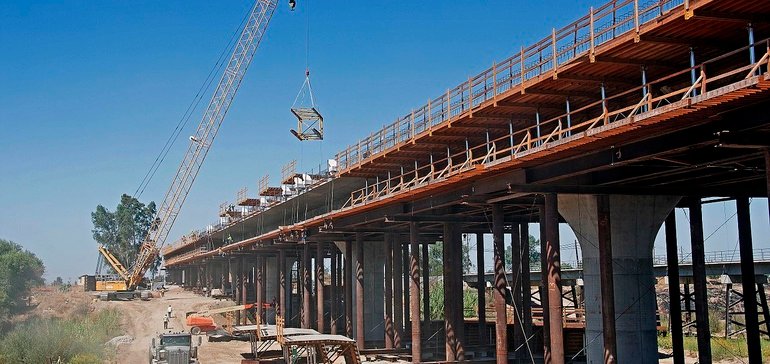California bullet train, two contracting teams have said that the state rail authority’s inability to secure land is creating delays. Here’s a look into what it means for the $100 billion project.
No one could call the California High-Speed Rail Authority’s bullet train project a model of success thus far. At an estimated cost of up to $100 billion — almost $70 billion more than the original estimate of $33 billion in 2018 — and approximately 13 years delayed, defending the project has been difficult even for its supporters.
The project, which will one day connect the San Francisco Bay area with Southern California, has been beset by challenges and controversy. Perhaps most notably, one of California Gov. Gavin Newsom’s first actions after he was sworn in in 2019, was to temporarily halt construction on all but the Central Valley portion of the project, a 119-mile stretch between Bakersfield and Merced now projected to cost $13.8 billion for construction, up from $12.4 billion last year.
The rail has also had to endure legislative scrutiny, kicked off by a Los Angeles Times investigation in 2016 that raised questions about the project’s management and oversight.
Most recently, the bullet train’s contractors have joined in criticizing the rail’s management and forthrightness in painting an accurate picture of delays. Last month, Dragados, part of the Dragados-Flatiron design-build contracting team that is currently working on a 65-mile segment of the Central Valley Line, wrote a letter to the CHSRA, according to the Los Angeles Times, informing the authority that they would be delayed by two years and that this delay was not included in the latest draft business plan.
The reason the joint venture gave for the schedule change is that the state’s land acquisitions were not predictable and that these holdups were interfering with the ability to schedule subcontractors and other construction activities.
However, a representative from the CHSRA told the Times that these delays can be mitigated and disputed complaints about faulty state land forecasts, saying they were the authority’s “best engineering guesses.”
In January, Tutor Perini leveled the same complaint against the CHSRA, calling its alleged failure to secure land for the project in a timely manner “beyond comprehension.” Tutor Perini is part of the joint venture working on a 32-mile portion of the rail.

A common problem
Accumulating the necessary land on a schedule set at the beginning of such a large undertaking as a statewide rail system is not a “uniquely California problem,” said attorney Allan Marks, a partner in the Los Angeles office of law firm Milbank LLP. For instance, the Central Texas $20 billion high-speed rail project that will connect Dallas and Houston, even though it is privately funded, has the power of eminent domain and still has had issues securing the land it needs, he said.
And in the California bullet train’s case, he added, the bond act that was approved by voters in 2008 required the authority to start the project right away, perhaps not giving the CHSRA enough time to acquire the land first.
“You don’t have certainty about what it’s going to cost or how long it’s going to take,” Marks said. “You just don’t. There are some advantages and cost savings because you’re starting sooner, but there are also tradeoffs that could increase your costs.”
One thing that the rail has in its corner is a new administration in Washington, D.C., one that seems to support the project despite the possibility that COVID-19 might have altered ridership patterns for the foreseeable future, said Randal O’Toole, a land use expert and senior fellow and at the Cato Institute nonpartisan think tank.
Amtrak ridership, he said, is down 75% due to the pandemic and even if most Americans receive a vaccination, there will likely be lingering worries about traveling in close proximity to other passengers, particularly with fears of mutations of the novel coronavirus and viruses yet to come. Combine that with a potential population shift to the suburbs, and that puts commuters even farther away from mass transit.
Still, President Joe Biden’s administration will back it, and the project will go on “as long as Congress is willing to fork over the money,” O’Toole said. This is in sharp contrast to the President Donald Trump administration, which was intent on depriving the California bullet train of its federal funding.
Looking ahead
As for how those in Los Angeles view the rail, Marks said, there are those who follow mobility issues and are confident the project will eventually be built but are frustrated that it has not made more progress by now. However, he said, Angelenos are more excited about the transit work going on around them right now.
The lack of traffic during COVID-19-related lockdowns has allowed construction to be accelerated on several commuter rail extensions and the new people mover to Los Angeles International Airport, Marks said.
“What people see in L.A. is local transit and commuter rail construction, and they know it’s all going to get done before the Olympics, so people are more excited about that,” he said.
Construct America Magazine | The Home of Construction Industry News




















